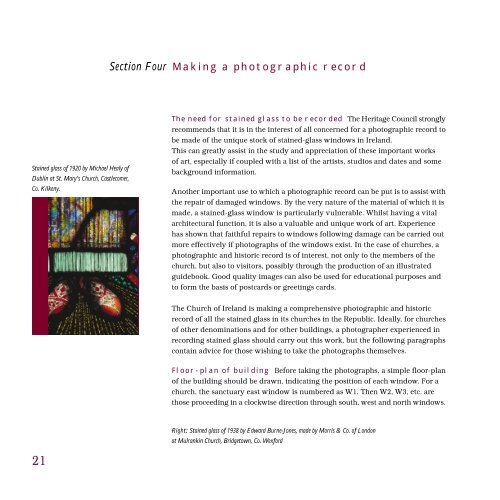Stained Glass - The Heritage Council
Stained Glass - The Heritage Council
Stained Glass - The Heritage Council
You also want an ePaper? Increase the reach of your titles
YUMPU automatically turns print PDFs into web optimized ePapers that Google loves.
Section Four Making a photographic record<br />
<strong>Stained</strong> glass of 1920 by Michael Healy of<br />
Dublin at St. Mary’s Church, Castlecomer,<br />
Co. Kilkeny.<br />
<strong>The</strong> need for stained glass to be recorded <strong>The</strong> <strong>Heritage</strong> <strong>Council</strong> strongly<br />
recommends that it is in the interest of all concerned for a photographic record to<br />
be made of the unique stock of stained-glass windows in Ireland.<br />
This can greatly assist in the study and appreciation of these important works<br />
of art, especially if coupled with a list of the artists, studios and dates and some<br />
background information.<br />
Another important use to which a photographic record can be put is to assist with<br />
the repair of damaged windows. By the very nature of the material of which it is<br />
made, a stained-glass window is particularly vulnerable. Whilst having a vital<br />
architectural function, it is also a valuable and unique work of art. Experience<br />
has shown that faithful repairs to windows following damage can be carried out<br />
more effectively if photographs of the windows exist. In the case of churches, a<br />
photographic and historic record is of interest, not only to the members of the<br />
church, but also to visitors, possibly through the production of an illustrated<br />
guidebook. Good quality images can also be used for educational purposes and<br />
to form the basis of postcards or greetings cards.<br />
<strong>The</strong> Church of Ireland is making a comprehensive photographic and historic<br />
record of all the stained glass in its churches in the Republic. Ideally, for churches<br />
of other denominations and for other buildings, a photographer experienced in<br />
recording stained glass should carry out this work, but the following paragraphs<br />
contain advice for those wishing to take the photographs themselves.<br />
Floor-plan of building Before taking the photographs, a simple floor-plan<br />
of the building should be drawn, indicating the position of each window. For a<br />
church, the sanctuary east window is numbered as W1. <strong>The</strong>n W2, W3, etc. are<br />
those proceeding in a clockwise direction through south, west and north windows.<br />
Right: <strong>Stained</strong> glass of 1938 by Edward Burne-Jones, made by Morris & Co. of London<br />
at Mulrankin Church, Bridgetown, Co. Wexford<br />
21

















